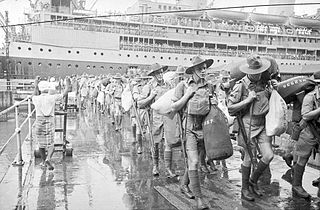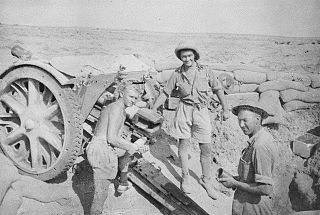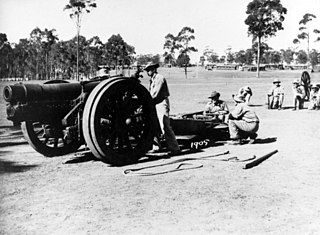
The 8th Division was an infantry division of the Australian Army, formed during World War II as part of the all-volunteer Second Australian Imperial Force. The 8th Division was raised from volunteers for overseas service from July 1940 onwards. Consisting of three infantry brigades, the intention had been to deploy the division to the Middle East to join the other Australian divisions, but as war with Japan loomed in 1941, the division was divided into four separate forces, which were deployed in different parts of the Asia-Pacific region. All of these formations were destroyed as fighting forces by the end of February 1942 during the fighting for Singapore, and in Rabaul, Ambon, and Timor. Most members of the division became prisoners of war, waiting until the war ended in late 1945 to be liberated. One in three died in captivity.
The 4th Regiment, Royal Australian Artillery is an artillery unit of the Australian Army. Currently it provides close artillery support to the 3rd Brigade and is based at Chau Pha Lines, Lavarack Barracks in Townsville, Queensland. The regiment was raised in its current form in 1960 and is currently re-equipping with M777A2 lightweight towed howitzers. The regiment deployed during Australia's commitment to the Vietnam War and has subsequently deployed to Singapore and East Timor.

'A' Field Battery is an artillery battery of the Australian Army. The unit has been in existence since 1871, having originally been raised as part of the New South Wales colonial defence force. As part of several different larger formations, the battery has served in many conflicts including the Sudan Campaign, the Second Boer War, the First World War, the Second World War, the Malayan Emergency, Confrontation, and the Vietnam War. Today it is part of the 1st Regiment, Royal Australian Artillery, attached to the 7th Brigade based at Enoggera, Queensland. It was previously an airborne unit, but no longer maintains that role. It is currently equipped with M777 howitzers.

The 2/4th Field Regiment was an Australian Army artillery regiment formed on 2 May 1940, as part of the 7th Division during World War II. The regiment was involved in campaigns in North Africa, Syria–Lebanon, Salamaua–Lae, the Finisterre Ranges and Borneo. After training in Victoria, the regiment deployed to North Africa in late 1940. After being deployed in the defence of Mersa Matruh in Egypt in early 1941, the regiment took part in the fighting against the Vichy French in Syria and Lebanon, before undertaking garrison duties there. It returned to Australia in early 1942 following Japan's entry into the war, and in September 1943, a small group of artillerymen from the 2/4th parachuted with two short 25 Pounder guns in the airborne landing at Nadzab airstrip in New Guinea in support of the US Army's 503rd Parachute Infantry Regiment. Later, the regiment took part in the 7th Division's advance through the Finisterre Range before returning to Australia in early 1944. Its final involvement in the war came around Balikpapan in 1945. After the war, the regiment was disbanded on 7 February 1946.
The 27th Brigade was a brigade-sized infantry unit of the Australian Army. The brigade was the last Second Australian Imperial Force infantry brigade raised for service during World War II. Initially assigned to the 9th Division, the brigade was transferred to the 8th Division shortly after it was raised. Training was undertaken around Bathurst, New South Wales throughout early 1941, before the brigade was sent to British Malaya in August 1941 to reinforce the 22nd Brigade, which had been dispatched earlier in the year. Following the Japanese invasion of Malaya, the brigade went into action in January 1942, taking part in the fighting along the western side of the Malay Peninsula. Its main action during this period came around Muar before the withdrawal to Singapore. In February, the brigade took part in the short lived Battle of Singapore. When the garrison surrendered on 15 February, the majority of the brigade's personnel were taken prisoner. They subsequently spent the remainder of the war in captivity before being released in August 1945.

The 22nd Brigade was a brigade-sized infantry unit of the Australian Army. It was briefly raised in 1912 as a Militia formation providing training as part of the compulsory training scheme. Later, during World War II, the brigade was raised as part of the all volunteer Second Australian Imperial Force in April 1940. Assigned to the 8th Division, in early 1941 the brigade was deployed to British Malaya where it formed part of the defensive garrison that was established there by the British, eventually establishing its headquarters in the Mersing–Endau area.

The 2/12th Field Regiment was an Australian Army artillery regiment formed as part of the all volunteer Second Australian Imperial Force for overseas during World War II. Recruited in the state of Victoria in early 1940, the 2/12th was initially formed as a medium artillery regiment, but was later converted to a field regiment due to a lack of medium guns. As a field regiment, the 2/12th deployed to the Middle East where they supported the 9th Division in several battles during the North African Campaign in 1941–42, and undertook garrison duty in Lebanon. In early 1943, the regiment returned to Australia and subsequently fought in New Guinea, seeing action against the Japanese during the Huon Peninsula Campaign in 1943–44 and then the Borneo Campaign in 1945.
The 2nd Malaya Infantry Brigade was a regular infantry brigade formed in 1940 with its headquarters in Singapore following the wartime expansion and reinforcement of Malaya Command. The Brigade participated in the Malayan Campaign and the Battle of Singapore against the Japanese until the surrender of the garrison in February 1942.

The 2/7th Field Regiment was an Australian Army field artillery regiment that served during the Second World War. Formed in mid-1940 and assigned to the 9th Division, the regiment was deployed to North Africa, where it saw action around Tobruk in 1941 and in the First and Second Battles of El Alamein in 1942. It also undertook garrison duties in Syria and Egypt. In 1943, the regiment returned to Australia, after which it did not see action again until late in the war when it was committed to the landing at Tarakan in 1945. Following the end of the war, the regiment returned to Australia and was disbanded in January 1946.

The 2/14th Field Regiment was an Australian Army artillery unit that served during the Second World War. Raised in late 1940 as part of the 8th Division, the regiment remained in Australia as a garrison force in Darwin when the division's infantry brigades were sent to various places around Southeast Asia to meet the threat posed by Japan. As a result, it did not deploy overseas until late 1943. In New Guinea, the regiment supported the 5th Division's operations on the Huon Peninsula throughout 1944 before deploying with them to New Britain in early 1945. From then, until the end of the war, the regiment engaged in operations against the large Japanese garrison on the island. At the end of the war, the 2/14th briefly undertook garrison duties on Rabaul as part of the 11th Division before returning to Australia and disbanding in January 1946.

The 2/20th Battalion was an infantry battalion of the Australian Army. Raised in mid-1940 as part of the 8th Division, the battalion was recruited from Second Australian Imperial Force volunteers drawn from the state of New South Wales. In early 1941, the 2/20th Battalion deployed to Malaya, where they formed part of the garrison there until December when the Japanese invaded. The battalion subsequently fought a brief campaign along the east coast of the Malay Peninsula before being withdrawn back to Singapore in early 1942. They were heavily engaged after the Japanese landed on the island, and were eventually captured following the Fall of Singapore. Most members of the battalion became prisoners of war, and a large number died in captivity.
The 2/15th Field Regiment was an Australian Army field artillery regiment that served during the Second World War. Raised in late 1940 as part of the Second Australian Imperial Force, the regiment was assigned to the 8th Division. In late 1941, it was sent to Singapore and subsequently fought in the Malayan Campaign before being captured after the Fall of Singapore.

The 2/11th Field Regiment was an Australian Army artillery regiment formed as part of the Second Australian Imperial Force during World War II. Formed in Victoria in mid-1940, the regiment was deployed to the Middle East in 1941 and subsequently took part in the fighting against the Vichy French in the Syria–Lebanon Campaign. In early 1942, they were brought back to Australia in response to Japan's entry into the war, and in 1943 joined the garrison in Darwin. Throughout 1944–45, the regiment was deployed to New Guinea before supporting the 3rd Division's campaign on Bougainville. After the war, the regiment was disbanded.
The 2/9th Field Regiment was an Australian Army artillery regiment formed as part of the all volunteer Second Australian Imperial Force in July 1940 for operations during World War II. Assigned to the 1st Australian Corps, the regiment was sent to the Middle East in mid-1941, and served in Palestine, Egypt, and Syria before returning to Australia in 1942. It undertook defensive duties in south-east Queensland before deploying north to Merauke, in Dutch New Guinea, and Cape York. It returned to Australia in October 1944 and sent to the Atherton Tablelands to carry out training as it waited for further deployment. This never came and the regiment was disbanded in late 1945.

The 2/2nd Anti-Tank Regiment was an Australian Army anti-tank artillery regiment that was raised for service during the Second World War. Formed in 1940 in Brisbane, Queensland, the regiment was assigned to the 7th Division and was deployed to North Africa in 1940, and subsequently undertook defensive duties in Egypt in 1941, before taking part in the Syria–Lebanon campaign. Garrison duties were undertaken in Syria, before the regiment was back to Australia in early 1942. It later fought against the Japanese in New Guinea and on Borneo before being disbanded in 1946.
The 9th Regiment, Royal Australian Artillery is an artillery regiment of the Australian Army. It draws lineage from an artillery unit raised in 1903, which provided personnel to artillery units raised for service during World War I seeing action on the Western Front. It was mobilised for service during World War II and undertook defensive duties in Australia before being disbanded in 1944. The regiment was re-raised as part of the Australian Army Reserve in 2018, and currently provides artillery support to the 2nd Division. It consists of six light batteries, which are based at numerous depots around the country. The regiment's headquarters is based in Sydney, New South Wales.

The 2/1st Medium Regiment was an artillery regiment of the Australian Army during World War II. Raised in 1940 as part of the all volunteer Second Australian Imperial Force, the regiment undertook garrison duties in Australia, Nauru and on Ocean Island, and served in the Middle East. It was converted to a field regiment, designated the 2/13th Army Field Regiment, due to a lack of howitzers, but was later converted back into a medium regiment. During 1943–1944, the regiment served as the 2/13th Composite Anti Aircraft Regiment before returning to the medium role. It was disbanded in July 1945, in Queensland.

The 2/4th Anti-Tank Regiment was an Australian Army anti-tank artillery regiment that was raised for service during the Second World War as part of the all volunteer Second Australian Imperial Force. It was formed in November 1940, and was assigned to the 8th Division. In early 1942, the regiment took part in the Malayan campaign and the Battle of Singapore before being captured when Singapore fell to the Japanese at which time most of its personnel became prisoners of war. Over 170 members of the regiment died in captivity before the end of the war in August 1945.

The 2/1st Anti-Tank Regiment was an Australian Army anti-tank artillery regiment that was raised for service during the Second World War as part of the all volunteer Second Australian Imperial Force. Formed in November 1939, it was sent to the United Kingdom in mid-1940, but was broken up and converted into infantry. In late 1940, the regiment was re-formed and deployed to the Middle East, joining the 6th Division. It took part in the Battle of Greece before being evacuated to Egypt. Later, the regiment took part in the Syria–Lebanon campaign. In early 1942, it was withdrawn back to Australia for service in the Pacific. En route the regiment was diverted to Ceylon for garrison duties. It served in New Guinea around Port Moresby and Milne Bay in 1942–1943 and then again in early 1945 during the Aitape–Wewak campaign, serving there until the end of the war.

The 2/3rd Anti-Tank Regiment was an Australian Army anti-tank artillery regiment that was raised for service during the Second World War as part of the all volunteer Second Australian Imperial Force. It was formed in July 1940, and was assigned to the 8th Division, but was later reassigned to the 9th Division. With this formation, the regiment took part in the Siege of Tobruk in 1941 and then the First and Second Battles of El Alamein in 1942. After returning to Australia in early 1943, the regiment became a corps-assigned unit, and its individual batteries served in New Guinea in 1943–1944, and then Borneo against the Japanese in 1945.














